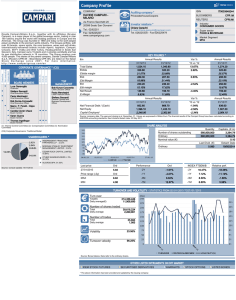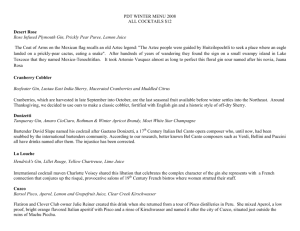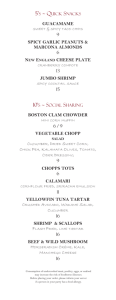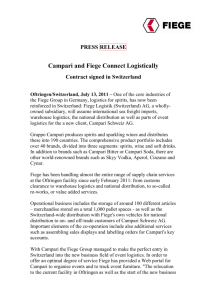Bitters and vermouth
advertisement
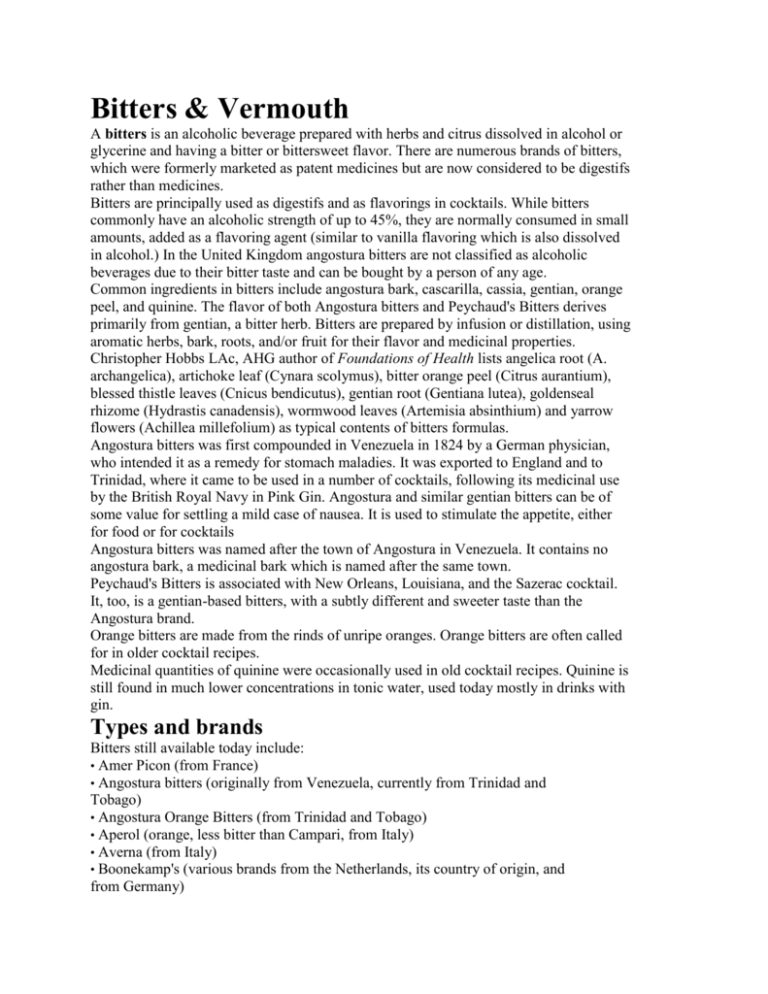
Bitters & Vermouth A bitters is an alcoholic beverage prepared with herbs and citrus dissolved in alcohol or glycerine and having a bitter or bittersweet flavor. There are numerous brands of bitters, which were formerly marketed as patent medicines but are now considered to be digestifs rather than medicines. Bitters are principally used as digestifs and as flavorings in cocktails. While bitters commonly have an alcoholic strength of up to 45%, they are normally consumed in small amounts, added as a flavoring agent (similar to vanilla flavoring which is also dissolved in alcohol.) In the United Kingdom angostura bitters are not classified as alcoholic beverages due to their bitter taste and can be bought by a person of any age. Common ingredients in bitters include angostura bark, cascarilla, cassia, gentian, orange peel, and quinine. The flavor of both Angostura bitters and Peychaud's Bitters derives primarily from gentian, a bitter herb. Bitters are prepared by infusion or distillation, using aromatic herbs, bark, roots, and/or fruit for their flavor and medicinal properties. Christopher Hobbs LAc, AHG author of Foundations of Health lists angelica root (A. archangelica), artichoke leaf (Cynara scolymus), bitter orange peel (Citrus aurantium), blessed thistle leaves (Cnicus bendicutus), gentian root (Gentiana lutea), goldenseal rhizome (Hydrastis canadensis), wormwood leaves (Artemisia absinthium) and yarrow flowers (Achillea millefolium) as typical contents of bitters formulas. Angostura bitters was first compounded in Venezuela in 1824 by a German physician, who intended it as a remedy for stomach maladies. It was exported to England and to Trinidad, where it came to be used in a number of cocktails, following its medicinal use by the British Royal Navy in Pink Gin. Angostura and similar gentian bitters can be of some value for settling a mild case of nausea. It is used to stimulate the appetite, either for food or for cocktails Angostura bitters was named after the town of Angostura in Venezuela. It contains no angostura bark, a medicinal bark which is named after the same town. Peychaud's Bitters is associated with New Orleans, Louisiana, and the Sazerac cocktail. It, too, is a gentian-based bitters, with a subtly different and sweeter taste than the Angostura brand. Orange bitters are made from the rinds of unripe oranges. Orange bitters are often called for in older cocktail recipes. Medicinal quantities of quinine were occasionally used in old cocktail recipes. Quinine is still found in much lower concentrations in tonic water, used today mostly in drinks with gin. Types and brands Bitters still available today include: • Amer Picon (from France) • Angostura bitters (originally from Venezuela, currently from Trinidad and Tobago) • Angostura Orange Bitters (from Trinidad and Tobago) • Aperol (orange, less bitter than Campari, from Italy) • Averna (from Italy) • Boonekamp's (various brands from the Netherlands, its country of origin, and from Germany) • Campari (from Italy) • Carpano Punt e Mes • Cynar (artichoke based liqueur from Italy) • Martini & Rossi ChinaMartini (from Italy) • Fernet Branca (from Italy) • Fernet Stock (from the Czech Republic) • Fernet 1882 (from [Córdoba - Argentina]]) • Gammel Dansk (from Denmark) • Jägermeister (from Germany) • Orange bitters • Peach bitters • Peychaud's Bitters (from Louisiana, United States) • Pimm's No. 1 • Riga Black Balsam (from Latvia) • Suze (from France) • The Bitter Truth-Aromatic-,Orange-and Lemon Bitters (from Germany) • Underberg (sometimes sold in health food stores, from Germany) • Unicum (from Hungary) • Zucco (from Italy) • Kina Lillet Campari is an alcoholic (alcohol 20.5%, 21%, 25% and even 28% depending on which country it is purchased) aperitif obtained from the infusion of bitter herbs, aromatic plants and fruit in alcohol and water. Campari is a type of bitters. Campari was invented by Gaspare Campari between 1862 and 1867. Today the product is still composed of the same original ingredients, thanks to a formula which has remained a secret for almost 150 years. History The history of Campari began in Novara, Italy, in 1860, with the invention by Gaspare Campari of the recipe that is still in use today. The recipe is kept confidential; according to Gruppo Campari, there is only one person in the world who knows the entire formula for the original family recipe. It is known that the colour came from natural Carmine Cochineal E120, but the Gruppo Campari in many countries has shifted to an alternative colorant. In 1904, Campari's first production plant was opened in Sesto San Giovanni, near Milano (Italy). The company required bars that bought Campari to display the Campari Bitters sign; under the direction of Davide Campari, Gaspare's son, the company began to export the brand, first to Nice, the heart of the French Riviera, then overseas. The Campari brand is now distributed in over 190 countries. In the Italian market, Campari mixed with carbonated water is sold in individual bottles as Campari Soda (10% alcohol by volume). Campari Soda is packaged in a distinctive bottle that was designed by Fortunato Depero; it was first created in 1932. Fernet is a brand of amaro produced in Milan, Italy. It is a bitter, aromatic spirit made from over 40 herbs and spices, including myrrh, rhubarb, chamomile, cardamom, aloe, and saffron, with a base of grape distilled spirits, and colored with caramel coloring. The drink, whose recipe is proprietary, was created as a medicine in Milan in 1845 by a young woman, Maria Scala. Scala's name became Maria Branca through marriage. The Fernet- Branca is still produced in Milan by the company Fratelli Branca, overseen by the Branca family, though the recipe of the Italian product differs slightly from that sold in America. Fernet-Branca is 45% alcohol by volume and is dark brown in color. Fernet-Branca is usually served as a digestif after a meal but may also be served with coffee and espresso or mixed into coffee and espresso drinks. It may be served at room temperature or on the rocks (with ice). A mint-flavored version of Fernet-Branca, Brancamenta, is also available. Angostura bitters, having an alcohol content of 44.7%, often simply referred to as angostura, is a concentrated bitters for food and beverages made of herbs and spices by House of Angostura in the country of Trinidad and Tobago. The recipe was developed as a tonic by German Dr. Johann Gottlieb Benjamin Siegert, a Surgeon General in Simon Bolivar's army in Venezuela, who began to sell it in 1824. Siegert was based in Ciudad Bolívar which was then known as Angostura, and used locally available ingredients. The single ingredient named on the label is gentian The exact formula is a closely guarded secret, with only five people knowing the whole recipe. As Angostura bitters are extremely concentrated, they are not normally drunk purely, but used to flavour drinks and food; usually only a few drops or dashes are used.Angostura bitters are a key ingredient in many cocktails. Originally used to mask the flavour of quinine in tonic water along with gin, the mix stuck in the form of a Pink Gin Vermouth Vermouth is a fortified wine flavoured with aromatic herbs and spices ("aromatized" in the trade) using closely-guarded recipes (trade secrets). Some of the herbs used may include cardamom, cinnamon, marjoram and chamomile. Some vermouth is sweetened; however, unsweetened, or dry, vermouth tends to be bitter. The person credited with the second vermouth recipe, Antonio Benedetto Carpano from Turin, Italy, chose to name his concoction "vermouth" in 1786 because he was inspired by a German wine flavoured with wormwood, a herb most famously used in distilling absinthe. However, wine flavoured with wormwood goes back to ancient Rome. The modern German word Wermut (Wermuth in the spelling of Carpano's time) means both wormwood and vermouth. The herbs were originally used to mask raw flavours of cheaper wines, imparting a slightly medicinal "tonic" flavour. Uses In addition to creating cocktails, vermouth can be used in place of white wine in cooking. Since it is fortified and shelf-stable, it makes a great substitute to keep on hand for cooking purposes since it will not sour like white wine can. Styles There are three general styles of vermouth, in order from driest to sweetest: extra dry, bianco/white, and sweet/red. Sweet red vermouth is drunk as an apéritif, often straight up, as well as in mixed drinks like the Manhattan. Dry white vermouth, along with gin, is a key ingredient in the mixing of martinis. Red vermouths are sometimes referred to as Italian vermouths and white vermouths as French vermouths, although not all Italian vermouths are red and not all white vermouths are French. Martini is a brand of Italian vermouth, named after the Martini & Rossi Distilleria Nazionale di Spirito di Vino, in Turin. Martini - Brands Martini is made from four ingredients: wine, botanicals, sugar and alcohol • Martini Rosso - 1863 • Martini Bianco - 1910 • Martini Extra Dry - This was launched on New Year's Day 1900. • Martini Rosato • Martini D’Oro - 1998 • Martini Fiero Noilly Prat, originally a dry, straw-hued vermouth from Marseillan, in the Hérault département of Southern France. Joseph Noilly, a herbalist, developed the first formula in 1813. It was the first example of a dry vermouth and is among the golden, straw and white vermouths generally known as "French Vermouth". Noilly Prat Dry is 18% alcohol by volume. Manufacturing process The process used today is virtually unchanged since the 1850s. Noilly Prat is made exclusively from white grape varieties grown in the Marseillan area, principally Picpoul de Pinet and Clairette. These produce light, fruity wines which are matured in massive Canadian oak casks inside the original storerooms. The wine stays in these casks for 8 months, maturing and absorbing the flavour of the wood, before being transferred to smaller oak barrels which are taken outside and left for a year. Here they are exposed to the sun's heat, wind from the sea and low winter temperatures, while the wine is slowly changing. The result is a wine that is dry, full-bodied and amber coloured similar to Madeira or Sherry. During the year outside, 6 to 8% of the volume is lost to evaporation, the "angels' share". Brought back inside and left to rest for a few months, the wines are then blended together into oak casks. A small quantity of Mistelle (grape juice and alcohol) is added to the wines in order to soften them, along with a dash of fruit essence to accentuate their flavour. In the oak casks, a process of maceration, supposedly unique to Noilly Prat, takes place over a period of three weeks. A blend of some twenty herbs and spices is added by hand every day. The exact mix of herbs and spices that goes into Noilly Prat is a closely guarded secret, but includes camomile, bitter orange peel, nutmeg, centaury, coriander, cloves. After a further six weeks, the finished product is ready for bottling and is shipped in tankers to Beaucaire, Gard where it is bottled by Martini & Rossi.
